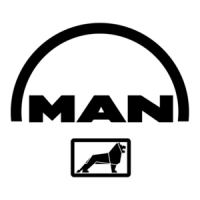
Do you have a question about the Man B&W S50ME-B9.3-TII and is the answer not in the manual?
| Bore | 500 mm |
|---|---|
| Cooling System | Water-cooled |
| Engine Type | Two-stroke |
| Cylinder Output | Varies by configuration |
| Number of Cylinders | 7 |
| Fuel Type | Heavy Fuel Oil (HFO) |
Provides key performance data including power, speed, and specific fuel oil consumption.
Explains the principles of engine layout and load diagrams using logarithmic scales.
Defines engine layout diagrams, operating curves, and limits for continuous operation.
Defines SFOC reference conditions, guarantees, and tolerances for engine performance.
Details the selection criteria for high-efficiency turbochargers for MAN B&W engines.
Discusses engine space requirements, overhaul heights, and lifting tool considerations.
Provides information on engine room crane capacity, lifting procedures, and coverage area.
Outlines engine seating requirements and approved epoxy chocks for installation.
Lists the components of the Engine Control System (ECS) installed in the engine control room.
Covers the scope, design, and installation of shaftline earthing devices to prevent spark erosion.
Introduces MAN Alpha CP propellers and the Alphatronic propulsion control system.
Describes the Alphatronic 2000 Propulsion Control System for diesel engines with CP propellers.
Describes how to calculate auxiliary machinery capacities and exhaust gas data for derated engines.
Provides detailed capacities for seawater and central cooling systems for a 5-cylinder engine.
Lists capacities for seawater and central cooling systems for a 6-cylinder engine.
Provides capacities for seawater and central cooling systems for a 7-cylinder engine.
Details capacities for seawater and central cooling systems for an 8-cylinder engine.
Lists capacities for seawater and central cooling systems for a 9-cylinder engine.
Explains how to calculate cooler capacities for derated engines using diagrams.
Explains influencing factors and calculation methods for exhaust gas amount and temperature.
Describes the pressurized fuel oil system, including heating and circulation for heavy fuel oil.
Provides specifications for marine diesel oil and heavy fuel oil, including guiding HFO specifications.
Details components of the fuel oil system, including centrifuges, pumps, and heaters.
Describes the fuel oil heater type, temperature control, and steam supply requirements.
Covers requirements for fuel oil filters, including duplex types, backflushing, and pressure drop.
Describes the lubricating and cooling oil system, including oil flow, collection, and venting.
Details the Hydraulic Power Supply (HPS) unit, its components, and function.
Covers lubricating oil consumption, centrifuge requirements, and lists recommended system oils.
Details components of the lubricating oil system, including pumps, coolers, and filters.
Details specifications for the full-flow lubricating oil filter, including flow capacity and cleaning criteria.
Outlines procedures for flushing lubricating oil components and piping before engine start.
Details the cylinder lubricating oil system, costs, and importance of optimization.
Recommends cylinder oils based on SAE viscosity grade and BN level for different fuel types.
Describes the Alpha Cylinder Lubrication System, its design, and control.
Explains the Alpha ACC system for adaptive cylinder oil dosage based on engine load and fuel quality.
Describes the piston rod stuffing box drain oil system, its purpose, and handling of drained oil.
Details the central cooling water system, including its characteristics and recommendations.
Lists components of the central cooling water system, including pumps, coolers, and thermostatic valves.
Describes the seawater cooling system, cooler positioning, and temperature control recommendations.
Details components of the seawater cooling system, including pumps, coolers, and thermostatic valves.
Specifies temperature and speed restrictions for engine starting, varying by propeller type.
Describes the starting and control air systems, including supply, reduction stations, and components.
Details starting air compressors, receivers, reduction stations, and piping.
Describes the scavenge air system, its components, and operating conditions.
Details the electrically driven auxiliary blowers, their function, and operating modes.
Explains the continuous draining system for the scavenge air box to prevent sludge buildup.
Covers fire extinguishing systems for scavenge air space using steam, water mist, or CO2.
Describes the exhaust gas system, its components, and turbocharger arrangements.
Covers exhaust gas system design, back-pressure limits, and velocity recommendations.
Lists components of the exhaust gas system and parameters for dimensioning.
Explains methods for calculating exhaust gas back-pressure, including pipe and component losses.
Describes the Engine Control System (ECS) for ME-B engines, its interfaces, and components.
Explains the purpose and operation of the Hydraulic Power Supply (HPS) unit.
Provides a layout diagram of the Engine Control System, showing component interconnections.
Illustrates the mechanical-hydraulic system integrating the HPS unit.
Details the ECS interfaces with ship control, alarm, and power management systems.
Discusses external unbalanced moments and their classification into categories.
Explains the origin of guide force moments and their effect on engine vibrations.
Recommends top bracing installation for engines to mitigate vibrations and improve resonance behavior.
Addresses 2nd order moments, their impact on 4, 5, and 6-cylinder engines, and resonance phenomena.
Discusses 1st order moments in 4-cylinder engines and their balancing methods.
Describes the advantages and installation of external electrically driven moment compensators.
Introduces Power Related Unbalance (PRU) as a measure for evaluating hull vibration risks.
Introduces monitoring systems and instrumentation for ME engines, including ECS, PMI, and CoCoS-EDS.
Explains the PMI Auto-tuning system for automatic adjustment of combustion pressures and engine performance.
Details the CoCoS-EDS condition monitoring system, including its full and basic versions.
Covers the alarm, slow down, and shut down systems for engine protection and unattended operation.
Explains the Bearing Temperature Monitoring (BTM) system for detecting bearing issues.
Describes the Bearing Wear Monitoring (BWM) system for predicting bearing wear.
Details the Water In Oil monitoring system for detecting water contamination in lubricating oil.
